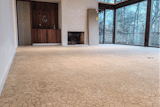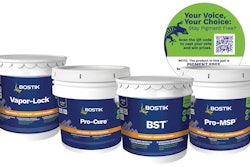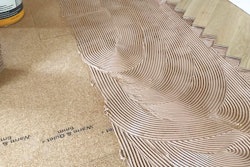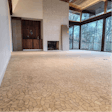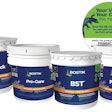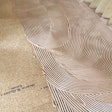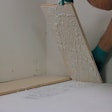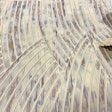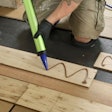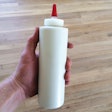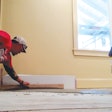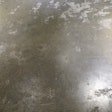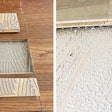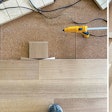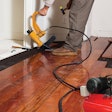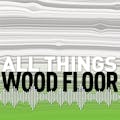
Shiny Spots
I recently installed a wood floor using a moisture-cure urethane adhesive and when I finished, the homeowner discovered adhesive residue on the surface of the wood. The adhesive was very difficult to remove and now there are cloudy and shiny spots on the wood. What happened?
Larry Scott, technical director at Carlstadt, N.J.-based DriTac Flooring Products LLC, answers:
The adhesive began to cure on the surface of the wood flooring. Moisture-cure urethane adhesives must be cleaned while they are wet. Once cured, moisture-cure urethane adhesives become very hard to remove. The cloudy and shiny spots are the result of burnishing or rubbing too vigorously on the surface of a low-gloss finish.
If you find cured moisture-cure urethane adhesive on the surface of the wood, apply a generous amount of a urethane adhesive remover/cleaner to the affected area and be patient. Allow the cleaner to work on the spot. Wipe or blot the area and repeat, if necessary, to remove the adhesive. Do not aggressively rub or scrape the finish, as this will polish the area to a higher gloss level. If the gloss level of the finish is affected, contact the flooring manufacturer for recoating information.
On a Roll?
It seems like most finish manufacturers are recommending rolling on their finishes these days. Can I assume today’s finishes can be rolled?
Cassandra Hope, development chemist at Baltimore-based Lenmar, answers:
The quick answer is “read the directions.” Many of today’s finishes can be rolled, but others cannot. Rolling creates more turbulence in the finish, forming and (depending on the finish) possibly entrapping bubbles.Often it depends on the type of finish. Solvent-based finishes tend to be more “rollable,” because they have a lower surface tension, making them much less likely to form bubbles and more likely to flow together to form a good-looking film.
That said, many of today’s waterborne finishes roll well. Since they do have a higher surface tension, they roll a bit better if they are thicker and have a proper “bubble-breaker”—or, chemically speaking, a defoamer. Defoamers work in opposition to flow agents; you need a balance of both to roll successfully.
Regardless, all finishes need a bit of time for the bubbles to break and a smooth, uniform film to form. Bubbles are reduced or eliminated when:
1. The bubbles break before the film begins to set. Open time has a lot to do with this. Heat, air flow and wet film thickness all affect this
2. The viscosity of the finish allows it to flow out quickly.
3. The proper roller is used so that the recommended application rate is maintained. Some manufacturers add training wheels to their rollers to ensure this. Generally, the recommendation is 3⁄8-inch for poly and ¼-inch for waterbornes. Splurge and buy a decent roller cover.
4. You don’t overwork the finish (that just makes more bubbles).
Nasty Nails
My customer is complaining about her dog’s nails scratching the finish. Isn’t that normal wear on the floor?
Rusty Swindoll, assistant technical training manager at the NWFA, answers:
I once went to a customer’s home because she was concerned about her dog wearing out her existing floor. As I rang the doorbell, I could hear a giant woof in the back of the house and the sound of huge feet running followed by the sound almost like an airplane landing in the front hallway. When the customer opened the door, I saw a giant dog, along with two tracks in the floor where the dog running to the door had worn through the finish and two layers of the existing engineered floor. Obviously, that floor had to be torn out and replaced.
While that case was extreme, scratches in a wood floor from pet nails are a common complaint. Keeping the pets’ nails trimmed and filed does help protect the floor. If the dog is walking normally, that shouldn’t typically damage the floor. But if you’re playing with your dog and throwing a ball, for example, and he’s running back and forth, that could scratch concrete, much less a wood floor. Eventually the dog’s nails will wear through the finish down to the bare wood. I always recommend that in high-wear areas, such as by the front door, where dogs tend to get excited and jump around a lot, customers cover the floor with a throw rug.
For minor scratches, a pad and recoat can restore the floor’s appearance. A regular recoat schedule helps prevent the wear from going through to bare wood (and requiring a total resand or even replacement). Always check with the flooring manufacturer for the recommended maintenance schedule.
Trick of the Trade: Keeping it Clean
By Steve Seabaugh

Once you’re done sanding and you’ve carefully cleaned every bit of dust off the floor, the last thing you want is to track dust from your shoes back onto the floor or leave black marks from the soles. Some contractors always wear booties over their shoes, but if you’ve forgotten them or run out, a few strips of blue tape stuck together and under your shoes work in a pinch.









